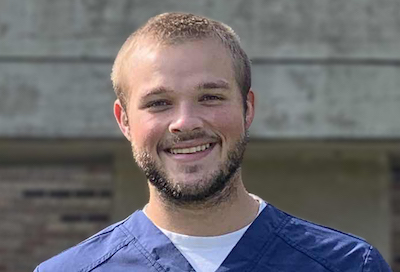October 5, 2020

Corbin Betz always knew he wanted to do something in healthcare, and after looking at a lot of different majors, he decided that Radiologic Technology (Rad Tech) would be an interesting choice.
In his senior year of high school Betz had to do a project, which consisted of 30 hours of shadowing at a hospital in Circleville. After talking to one of his brother's friends, who worked at the hospital, and who completed the Rad Tech program at Shawnee, Betz was convinced he wanted to study the subject.
“At times it was a little bit challenging to combine SSU soccer and the radiology program,” Betz said. “Especially with clinical hours, which are three eight-hour days, it required a lot of planning and making sure to not postpone work.”
Betz found the program provided extensive experience in hospitals.
“The clinical experience that you get is really important,” Betz said. “You learn a lot in the classroom, but with the hands-on experience you get to actually get to apply and practice it. You gain a lot of experience working and interacting with patients.”
Toward the end of the program, the Rad Tech students created a resume to be able to apply for jobs.
“You might not have a lot of work experience coming out of college yet, but the abundance of clinical experience is really important and gives you the ability to have a great resume,” he said.
The Rad Tech program started Betz on his career path. He plans within five years to be working as a dosimetrist, which is someone who plans radiation treatments for cancer patients. During the SSU program, the students toured the SOMC Cancer Center. They examined all the different career fields that were possible with radiation therapy and dosimetry stood out to Betz.
Admission into SSU’s Rad Tech program is competitive. Applicants need at least 10 hours of shadowing, need to have a high GPA and ACT score. Typically, students take introductory math and science courses in their first year as they build a foundation toward their radiography and clinical education. The program is normally a six-semester schedule for the Rad Tech student.
In high school, Betz completed several college classes, which made it possible for him to get into the Radiologic Technology program straight out of high school.
The small size of Shawnee made Betz feel at home. “You get to know your professors and your classmates really well; you create relationships with them and go through the program together,” he said.
People think Radiologic Technology is a difficult program with a lot of work, but Betz said that once you get to the end of it, all the hard work is rewarding. His advice for someone considering the program?
“Just go for it! There are a lot of different options and careers when you graduate from the program,” he said. “There are so many opportunities.”
For anyone with questions or interest in the Radiologic Technology program at Shawnee State, please contact Program Director Sheena Shifko, (740) 351-3247 or email sshifko@shawnee.edu.
